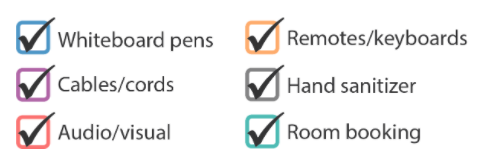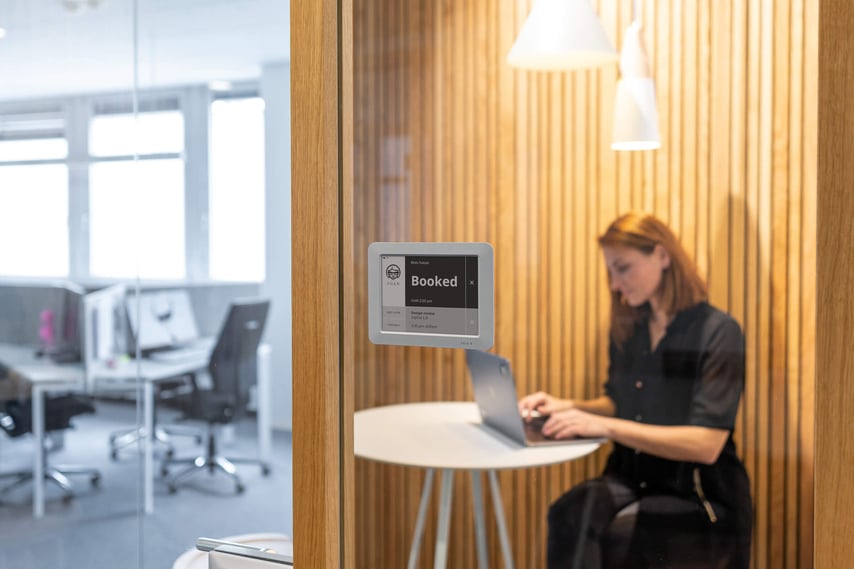The checklist in this article might seem obvious, but we always forget how stressful hosting a meeting can be until we’re faced with one. In Drivers Ed, we’re taught to walk around our car before getting in. Every time. But do we? No, we don’t.
Should you walk around your car every time before you get in? You probably should, especially when you’re driving other people around. The same goes for meetings: if you’re hosting a meeting and your teammates are relying on you, take precautions to help it run smoothly.
Consider having a “Pre-meeting conference room equipment checklist” for major meetings: a list of essential tools and resources you should make sure are in the room before you settle down before your meeting starts.

This article offers a list of common meeting essentials to consider for your checklist.
Whiteboard pens
Let’s specify: functional whiteboard pens. Not only do we know what it’s like to enter a meeting room where the pens have all been misplaced, but we also know what it’s like to try one, two, even three whiteboard markers before finding one that works. Make sure the markers in the meeting room are not only present, but work.
Better yet, keep one or two with you in case any of them wander off in the hours before your meeting.
Cables and cords
Ask yourself one thing: might your laptop need an adapter? If you’re sharing from your phone, does your phone need an adapter? Too many hard-working individuals have spent hours on a presentation only to find they can’t use it upon entering the room; they don’t have the right cables or adapter.
Furthermore, always do a quick check to make sure everything is plugged in and working from computer to camera.
Audio and visual tools
Don’t just make sure these tools exist in the room: make sure they work. Host a test meeting before the big event to make sure the camera and microphone are fully functional. For the best possible experience, set up JabraPanacast and connect it with Joan 6 (a room booking system).
The camera will detect the number of people in the meeting room and send this information to Joan. Joan will, then, either book or release the room automatically.
Additionally, fine-tune the room’s speaker settings to make sure participants joining online can be heard.
Remotes and keyboards
Don’t just find the room’s remotes and keyboard, place them where they’ll help the most. It’s one thing to know there’s a keyboard in the room, it’s another to place it where you’ll be presenting so you can troubleshoot and navigate as needed. The same goes for any and all remote controls.
Hand sanitizer
Hand sanitizer is the most “of-the-times” necessity on this list. Not only is it mandatory, but it protects everyone’s health in the simplest way possible. By now, we all got kind of used to sanitizing our hands and it’s only natural that people will continue to sanitize their hands even after we’ve been given the all-clear to go back to the office.
Hand sanitizer is here to stay: at least for a while.
Room booking system
Book your room. Obvious, but still essential. If you have a meeting room booking system display such as Joan, booking your room in advance can keep out squatters or ad hoc gatherings, leaving the room free for your meeting.

If you haven’t had an opportunity to iron out your technology in advance, book your room a half-hour before your meeting to set up.
Conclusion
Most of us have entered a meeting room and started a meeting only to find the whiteboard markers missing, the big-screen mouse and keyboard nowhere to be found, the cable you need to connect your computer to the monitor walked off somewhere…
Usually, you can shrug it off and blame previous users, IT, or call it bad luck. But that’s not going to help us having a better meeting.
Are you just renovating your meeting rooms and don’t know where to start? Well, a room booking system will save you time managing meeting rooms and enable contact tracing when necessary. Learn more about it.
Insights that keep your office running smoothly
Fresh content on productivity, space management, and the future of work. Perfect for managers, admins, and busy teams.
Join thousands of workplace professionals who already read the Joan blog. Unsubscribe anytime.